
Top 10 Retool Alternatives & Competitors for 2026
Retool is one of the biggest players in the low-code space. However, that doesn’t mean it’s the right choice for every business. Today, we’re checking out some of the top Retool alternatives from across the market. And it’s a crowded market nowadays. However, there’s huge variation between different options - across their pricing, features, target personas, use cases, and more.
Today, we’re covering the following:
- What is Retool?
- Why would you look for an alternative to Retool?
- 10 Retool alternatives for 2026
- Retool vs Budibase
- How to choose a low-code platform
Let’s get right into it.
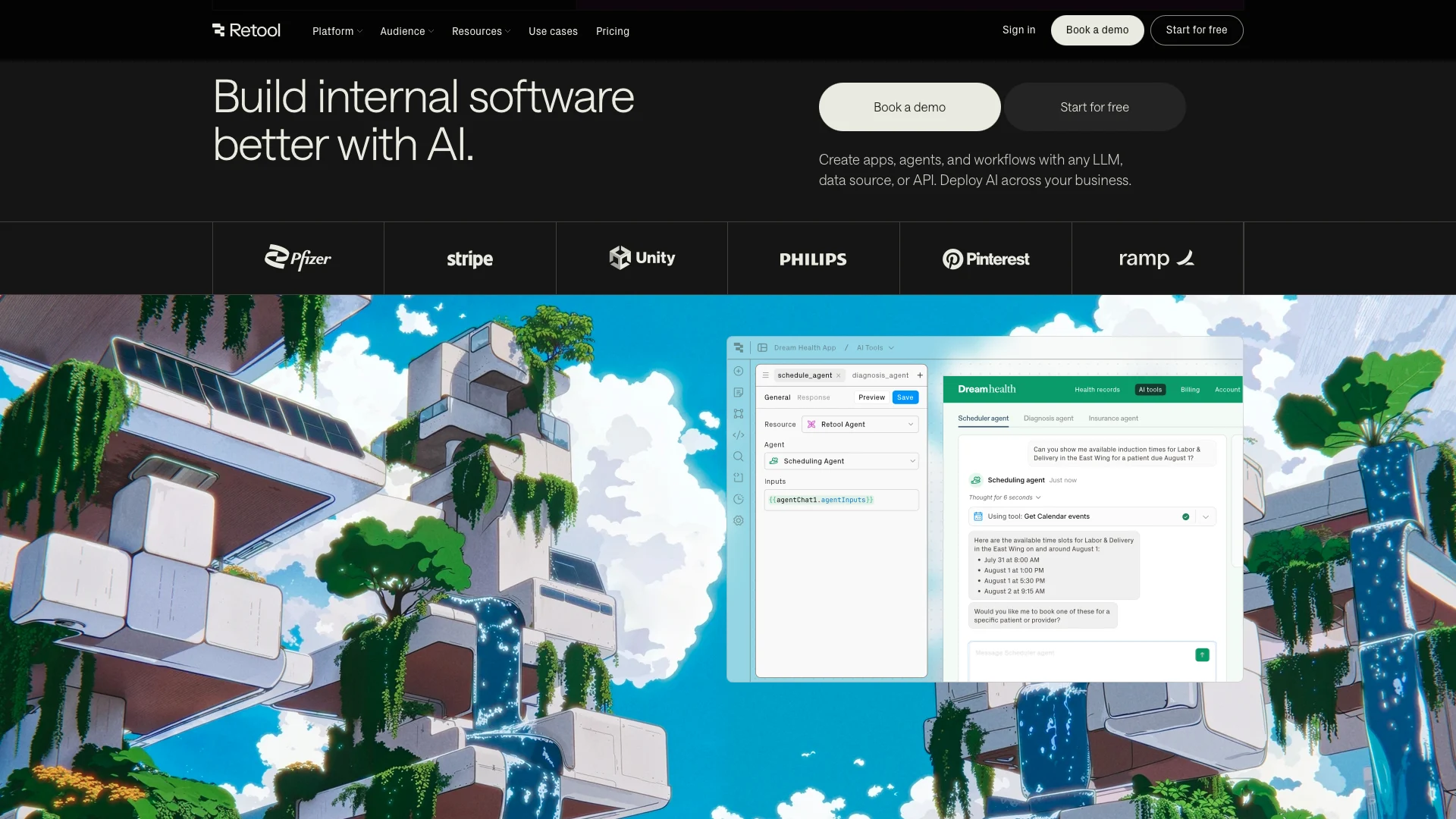
(Retool Website)
What is Retool?
Launched in 2017, Retool is a development platform for building internal software.
Like any low-code platform, the goal is to reduce the time and development resources required to ship simple solutions - like forms, CRUD apps, admin tools, portals, or other workflow applications.
A large part of Retool’s popularity relates to its early market entrance.
Besides this, its strengths include:
- Large component library - Retool offers a large number of pre-built components for building UIs.
- Integrations - An extensive library of API and data source integrations.
- Workflow automations - A flow-based UI for building automations and scheduled jobs.
- AI capabilities - Retool offers integration with external AI models as well as its own built-in AI assistant for writing JavaScript and SQL queries, and, more recently, agent-building functionality.
- Version control - Support for multiple app versions, alongside Git syncing.
- Enterprise features - Like SSO, audit logging, self-hosting, and enterprise support.
- Access control - Granular role-based access control.
On paper, this is an attractive offering for development teams that need to create working solutions quickly.
So…
Who uses Retool?
First and foremost, Retool is aimed at developers. The ultimate goal is to expedite internal tool projects, enabling companies to dedicate more resources to their core product.
In other words, the target users are developers who don’t have time to spend on more menial tasks.
This can take a few different key forms. For example, Retool is popular with back-end developers who are comfortable with configuring and handling data, but might not necessarily have advanced UX or design skills.
Another key technical persona is full-stack developers who need to save time through reusability, expedited deployments, and reduced support and maintenance burdens.
However, Retool isn’t exclusively for developers. Less technical colleagues in plenty of organizations also find it helpful to allow them to build working solutions - without necessarily knowing how to code.
Compared to some other platforms, though, the technical barriers to entry may be relatively high for these kinds of users - since you could need coding skills for a lot of more advanced use cases.
That leads us to our next question.
Why would you look for a Retool alternative?
If you’re here today, one of two things is happening. Either you’re currently using Retool and looking to switch to a competitor - or you’re weighing up your options without ever adopting a low-code platform.
In either case, it’s important to be familiar with the areas where Retool falls short.
These include the following:
Retool is entirely closed-source. This means that the source code is not publicly available. As such, an open-source alternative may be a priority for many businesses, as Retool will likely interact with mission-critical databases, infrastructure, and processes Retool suffered major reputational damage in August 2023 after being the victim of a significant data breach, resulting from a phishing attack. Multiple user accounts were compromised, resulting in sensitive data being leaked. This allegedly cost one customer as much as $15 million. For many businesses, Retool’s pricing also makes it unviable. Like most other vendors in this space, Retool operates on a per-seat basis, with separate billing for app developers and end users. Depending on your needs, other Retool alternatives may be more cost-effective. For example, their business tier is limited to 25 users - while features like SSO and custom branding are limited to the enterprise tier. Retool is a highly modern platform, but some tasks can be more streamlined in alternative tools, especially for less technical colleauges. At the other end of the low-code spectrum, some technical users might find that more advanced platforms offer them more flexibility and scope for customization.Closed-source code
Security concerns
Pricing
Target usage
10 Retool Alternatives for 2026
With that bit of context out of the way, we can start to think about some of the best platforms to bridge this gap as alternatives to Retool.
We’ve chosen ten tools from different points across the low-code market:
Let’s jump right in.
 Retool |  Budibase |  Mendix |  Outsystems |  Appian |  PowerApps |  AppSheet |  Filemaker |  Zoho Creator |  Quickbase | Caspio | |
|---|---|---|---|---|---|---|---|---|---|---|---|
| Pricing Model | Per creator + per user | Per creator + per user | Flat fee + per user | Custom | Per user + usage-based | Per user | Per user | Per app | Per user | Per user | Fixed |
| Open-Source | |||||||||||
| Built-In Database | |||||||||||
| Custom Components | |||||||||||
| Automation Builder | Via Power Automate | ||||||||||
| SSO | Paid | Free | Paid | Paid | Paid | Paid | Paid | Paid | Paid | Paid | Paid |
| Security certs | SOC 2 | ISO27001 | ISO27001 + SOC 2 | ISO27001 + SOC 2 | ISO27001 + SOC 2 | ISO27001 + SOC 2 | ISO27001 + SOC 2 | ISO27001 + SOC 2 | ISO27001 + SOC 2 | ISO27001 + SOC 2 | ISO27001 + SOC 2 |
| App Embeds |
1. Budibase
Budibase is an open-source, low-code platform that helps teams turn data into action. Our goal is to make it as fast and easy as possible to connect to existing data, build interfaces, automate tasks, and ship professional web applications.

Thousands of companies in all kinds of industries choose Budibase to save time and money building internal tools that integrate seamlessly with any workflow.
We will do a fuller comparison of Budibase and Retool a little later. For now, here’s what makes our platform tick.
Features
Budibase enables teams to share, manipulate, and collaborate on data in a safe reliable way. We offer a huge range of dedicated connectors for all kinds of SQL and NoSQL databases, alongside REST APIs, Google Sheets, and our own built-in database.
You can even build your own custom data sources using our dedicated plug-ins CLI.
The app-building experience is tightly centered around the Data section. Use your connected data to build custom filtering and transformation views, set permissions for specific user roles, and autogenerate secure UIs and automation rules.
Building professional interfaces in Budibase is easy - even for non-designers. You can build clean, user-friendly front ends in minutes with reusable components, autogenerated screens, and an intuitive drag-and-drop interface.
Budibase also offers flexible branching automations, RBAC, free SSO, multi-user collaboration, extensive integrations, and optional self-hosting, including air-gapped deployments.
On top of this, we offer powerful AI capabilities across the Budibase builder, including within the data section, as automation actions, or for generating table schemas and custom JavaScript, all powered by OpenAI, Azure, or Budibase AI.
Use cases
As a Retool alternative, Budibase is ideally suited to building internal tools and workflow apps. For instance, CRUD tools, approval apps, forms, portals, admin panels, and other simple tools that form the backbone of your internal processes.
IT teams, data professionals, and other technical professionals choose Budibase to simplify development processes and transform workflows.
Check out our product overview to learn more.
2. Mendix
Mendix is one of the oldest names in the low-code space. Like Retool, the goal is to expedite internal tool projects - but with an even heavier slant towards professional developers.
There’s a clear focus on development teams within larger organizations and enterprises. For instance, Mendix offers a suite of features aimed explicitly at integrating into SCRUM lifecycles.
Pros
One of the really big selling points here is Mendix’s built-in IDE - Mendix Studio Pro. This combines a drag-and-drop interface for building interfaces with more traditional development tools, like substantive code editing, version control, and generative AI.
Mendix is also a strong offering in terms of extensibility. Like any low-code platform, there is a large number of integration options available. What sets Mendix apart, however, is its SDK which facilitates a huge range of admin, analysis, and legacy modernization actions.
Lastly, Mendix has a large, active community of developers. This means that there is an abundance of resources for expanding capabilities, solving key pain points, and generally maximizing value from the platform.
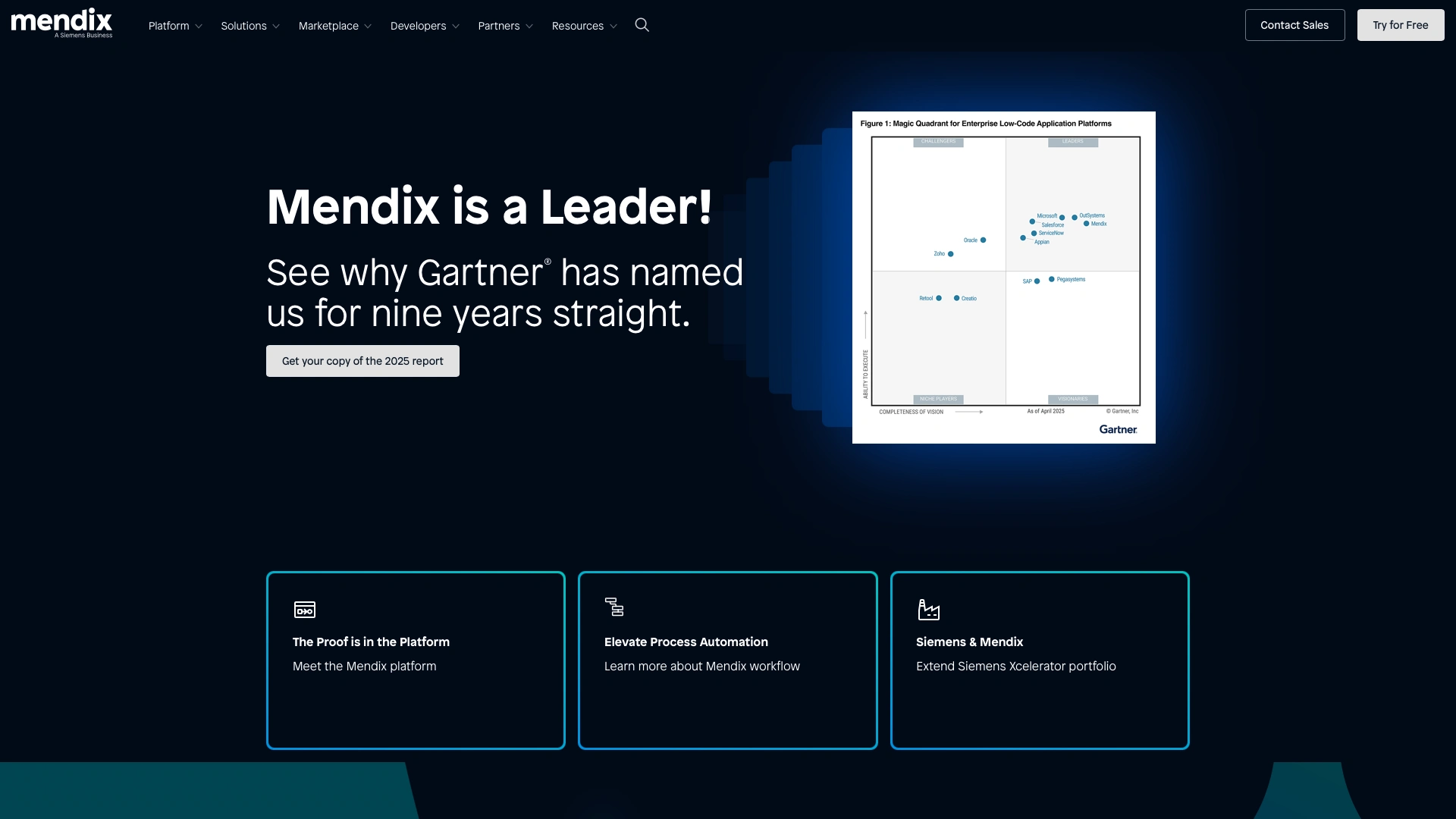 (Mendix Website)
(Mendix Website)
Cons
Compared to Retool - and other alternatives - Mendix presents a relatively high technical skills barrier for developing solutions. Low-code is a spectrum and Mendix sits towards the code-reliant end, particularly when it comes to creating more sophisticated applications.
A great example of this is the developer experience around building UIs. There’s somewhat limited customization for designing screens without editing CSS - even for basic tasks like app theming.
Finally, some users complain of performance issues as Mendix applications scale, without specific optimization actions. For instance, Mendix recommends implementing batching to improve performance when commiting large volumes of data.
Pricing
Mendix is generally one of the more expensive low-code platforms on the market. There are three pricing tiers for single-app users - free, standard, and premium. Premium is the custom option for enterprises.
Standard bills at $998 per month. One notable downside here is that this doesn’t include the required hosting and compute resources, which will be billed separately.
If you want to build multiple applications, the cheapest paid option is the standard tier at $2495 per month, plus each additional user. This is a large jump from an already expensive license, creating real issues with scalability.
3. OutSystems
OutSystems is another veteran in the low-code market. Like Mendix, it’s heavily focused on development teams within enterprises.
Given its enterprise focus, OutSystems is built with more complex full-stack development processes in mind. So, it offers a range of dedicated tools around things like testing, user management, and data modeling. Like many low-code platforms, it’s also introduced a suite of tools for building and managing AI agents in recent years.
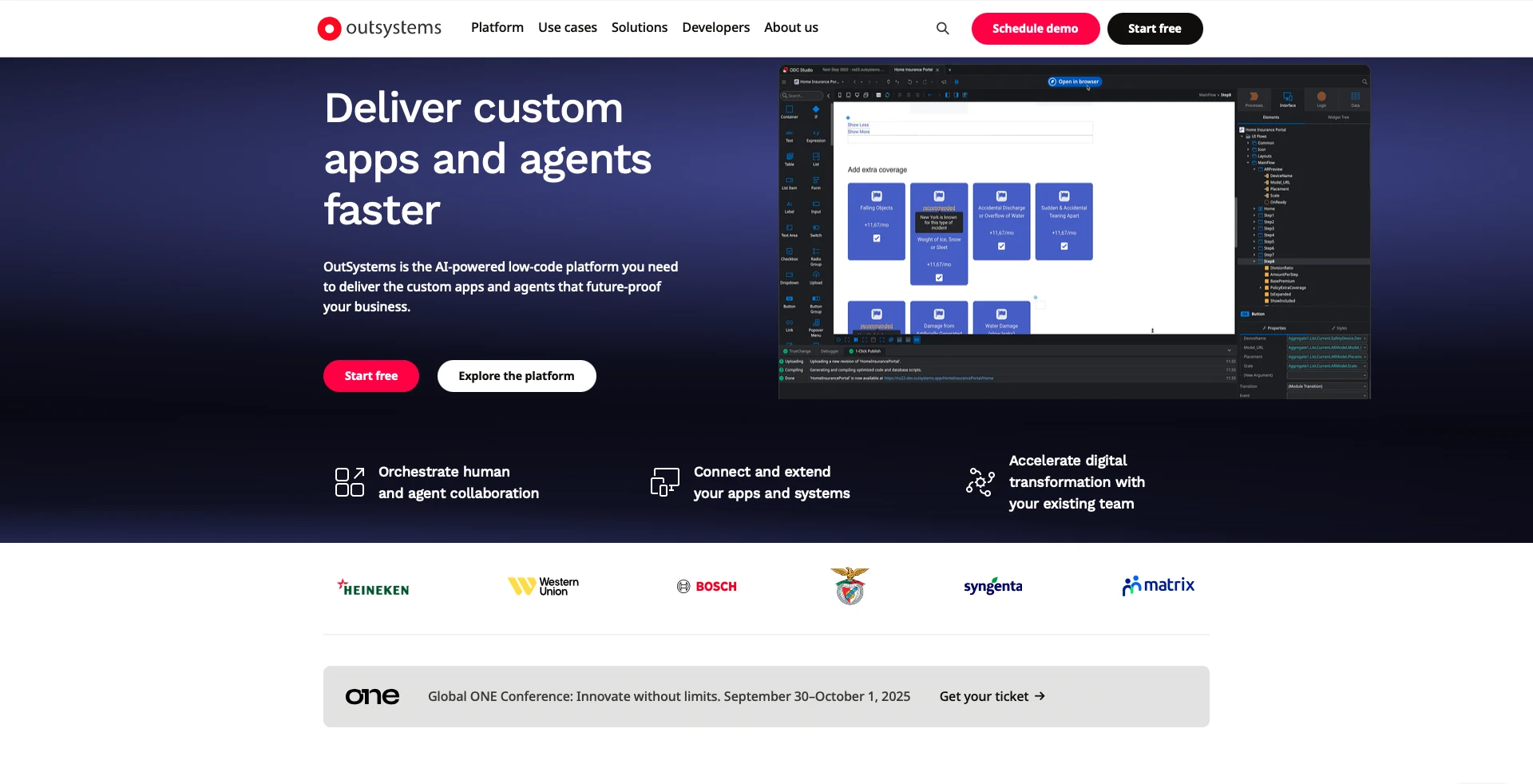 (OutSystems Website)
(OutSystems Website)
Pros
One particular area where OutSystems really shines multi-platform development. Like most low-code platforms, it’s an effective tool for building cloud-native web applications - but it’s also highly suited to native app development for Android and iOS.
The Forge marketplace also introduces a huge scope for customization and reusability. Users can build code modules, data connectors, and custom UI components to leverage across their apps - as well as pulling in existing community contributions.
OutSystems’ generative AI functionality is impressive - particularly with regard to testing and performance monitoring - with models aimed at assessing your app’s architecture, custom code, and maintainability using AI assistance.
Cons
OutSystems is comparatively difficult to get up and running. Self-hosting or local instances require the separate installation of several packages - whereas other Retool alternatives offer one-click installations.
There is a proprietary cloud-based service, but it’s worth noting that this does not have full feature parity with the self-hosted option, according to OutSystems’ own docs.
Once installed, OutSystems also has a comparatively steep learning curve. As a developer-focused platform, you’ll need to get familiar with the platform’s own architecture, which can make OutSystems feel more tailored towards professional engineers and other technical personas.
Pricing
OutSystems pricing is fairly distinct within the low-code market, taking account of user volumes, as well as a proprietary concept known as Application Objects (AOs). This includes all aspects of how we build applications, including databases, tables, screens, API requests, and more.
Licenses for OutSystems Developer Cloud start from $36,300 for a single application with up to 100 internal users. We’ll then need to pay additional fees for extra users, building multiple apps, or 24/7 support.
Self-hosting is also billed as an advanced add-on.
4. Appian
Appian is a departure from some of our other Retool alternatives. It’s still primarily aimed at automating processes and workflows within large enterprises, especially in terms of implementing AI in mission-critical processes.
In line with this, the core functionality is more aimed at process transformation than application development per se. Although, there’s obviously a lot of overlap between these and, in practice, the end solutions might be very similar.
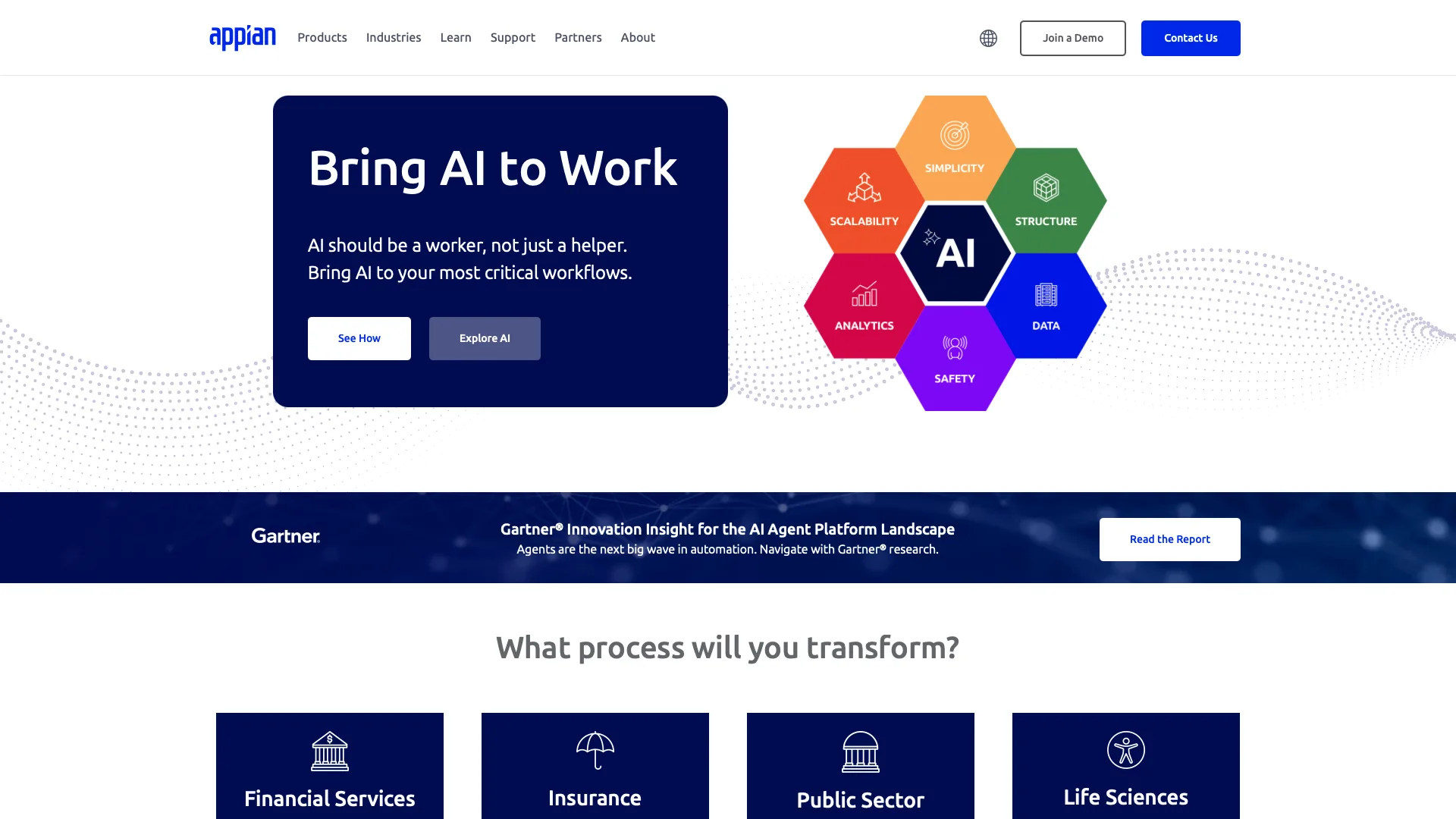 (Appian Website)
(Appian Website)
Pros
Appian is one of the most attractive options here in the realm of process automation - with a range of native tools around process orchestration, robotic process automation, AI modeling, and API integration. This is all centered around a diagram-based process builder.
Its process discovery tools are particularly impressive, with a range of monitoring, learning, and analytics features for gaining insight into how your business processes work in the field and taking action based on this. It’s also particularly strong on implementing security controls over AI-based solutions.
Appian isn’t as reliant on custom code as Mendix or OutSystems, meaning that a greater range of colleagues can create solutions. There are also dedicated governance functions, so IT teams can still retain control over what is built and how.
Cons
Given its target user base, Appian is arguably somewhat limited in terms of flexibility and customization - particularly when building UIs.
Users also complain that Appian can present a relatively steep learning curve.
There are also reported performance issues when dealing with large volumes of data. In a similar vein, the diagram-based UI for building automations may not be the most intiutive for iterative processes - particularly on a larger scale.
Pricing
Appian offers three distinct pricing tiers, on a per-user per-month model - Standard, Advanced, and Premium.
However, the specific costs associated with each of these are not currently publicised on their pricing page.
Each tier implements distinct feature and usage restrictions. For example, we’ll need an Advanced license to access most AI capabilities.
5. PowerApps
Microsoft’s offering, PowerApps, is probably the most ubiquitous player in the low-code market.
As you might expect, this is an attractive option for businesses that are highly embedded in the Microsoft ecosystem - with close integrations with tools like SharePoint, CoPilot, Dynamics, SQL Server, and Power BI.
However, many PowerApps developers tend to be platform specialists - and it doesn’t exactly have a reputation for being easy to get to grips with.
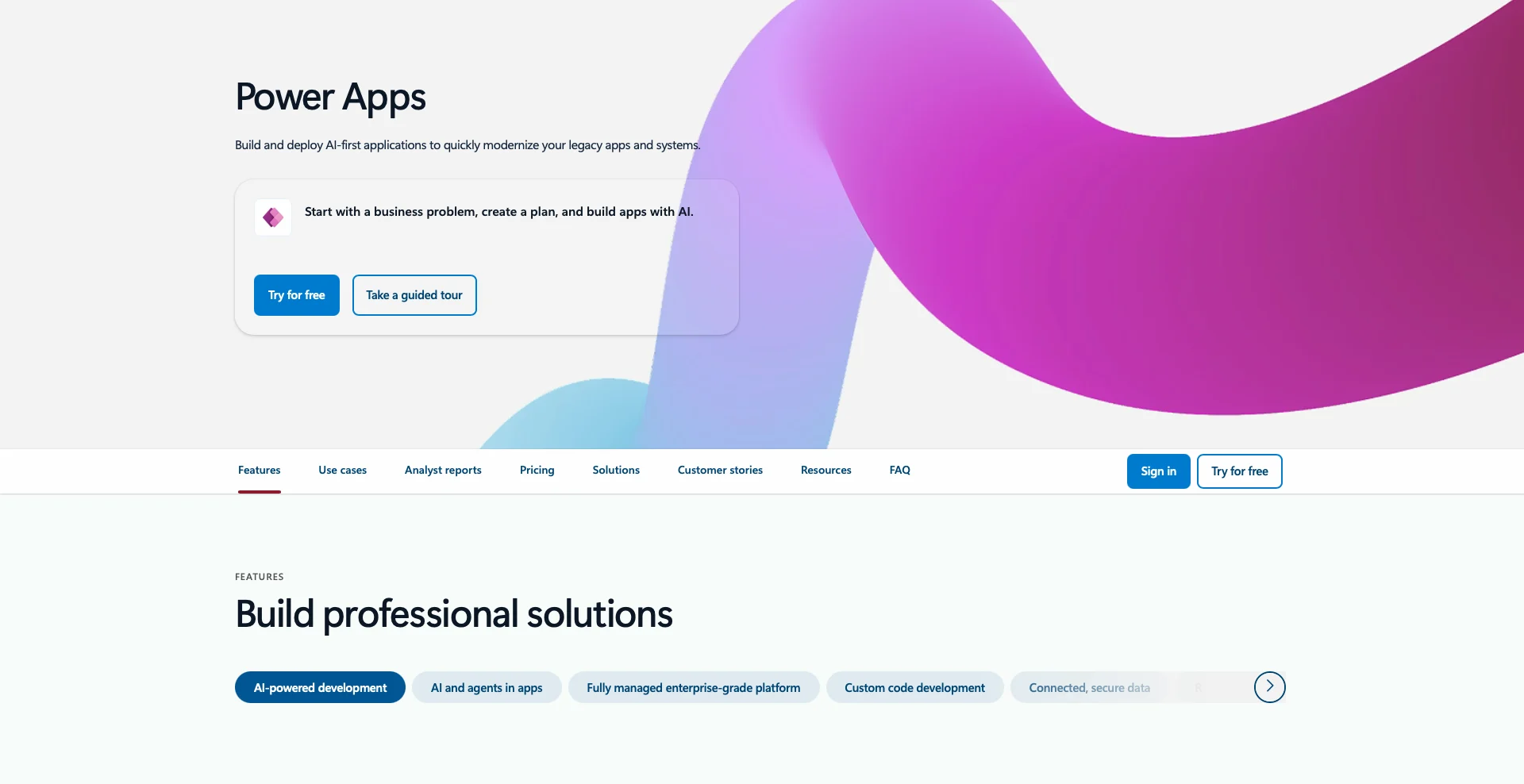 (PowerApps Website)
(PowerApps Website)
Pros
Microsoft provides a vast number of sample applications and templates to help kick-start projects. This is obviously a big benefit if you want to build applications around relatively generic business processes.
Close integration with the rest of the Microsoft ecosystem can also be a major selling point, particularly if your business is already heavily reliant on Excel, Power BI, Dynamics, or other Microsoft platforms.
PowerApps uses a proprietary language called Power Fx to handle application logic. This is derived from Visual Basic, meaning that it will be relatively familiar to business users with a high skill level in Excel.
Cons
The biggest detractor from PowerApps is its steep learning curve. For example, learning Power Fx properly takes time - whereas other Retool competitors allow you to simply jump in with more common languages like JavaScript.
On top of this, Power Fx is fairly notorious for being strict on syntax and formatting. Many users report problems with getting PowerApps to do what they want when creating complex logic.
Since PowerApps isn’t a standalone tool, but a part of the wider Power suite, relatively simple tasks like connecting new data sources can also be fairly convoluted - especially compared to other solutions in this class.
You may also need a license for Power Automate if you want to handle business logic effectively.
Pricing
Another key reason for PowerApps’ ubiquity is its affordable, simple pricing model. There’s a usable free tier, giving us two developer environments, 2 gb of Dataverse storage, and 750 automation runs per month.
Paid plans for unlimited apps start from $12 per user per month, with a 2000-seat minimum, making Power Apps a highly affordable option for roll-outs to large organizations.
For teams with less than 2000 users, Power Apps bills at $20 per month, meaning it’s still potentially good value for money for a range of organizations.
6. AppSheet
Next, we have AppSheet - Google’s offering in the low-code space.
So, like PowerApps, there’s a clear bias towards the vendor’s wider ecosystem. However, out of all of the Retool alternatives we’ve seen - it’s the most suited for non-technical users who want to build applications.
AppSheet’s developer experience is tightly focused on combining no-code with Google’s proprietary AI tools.
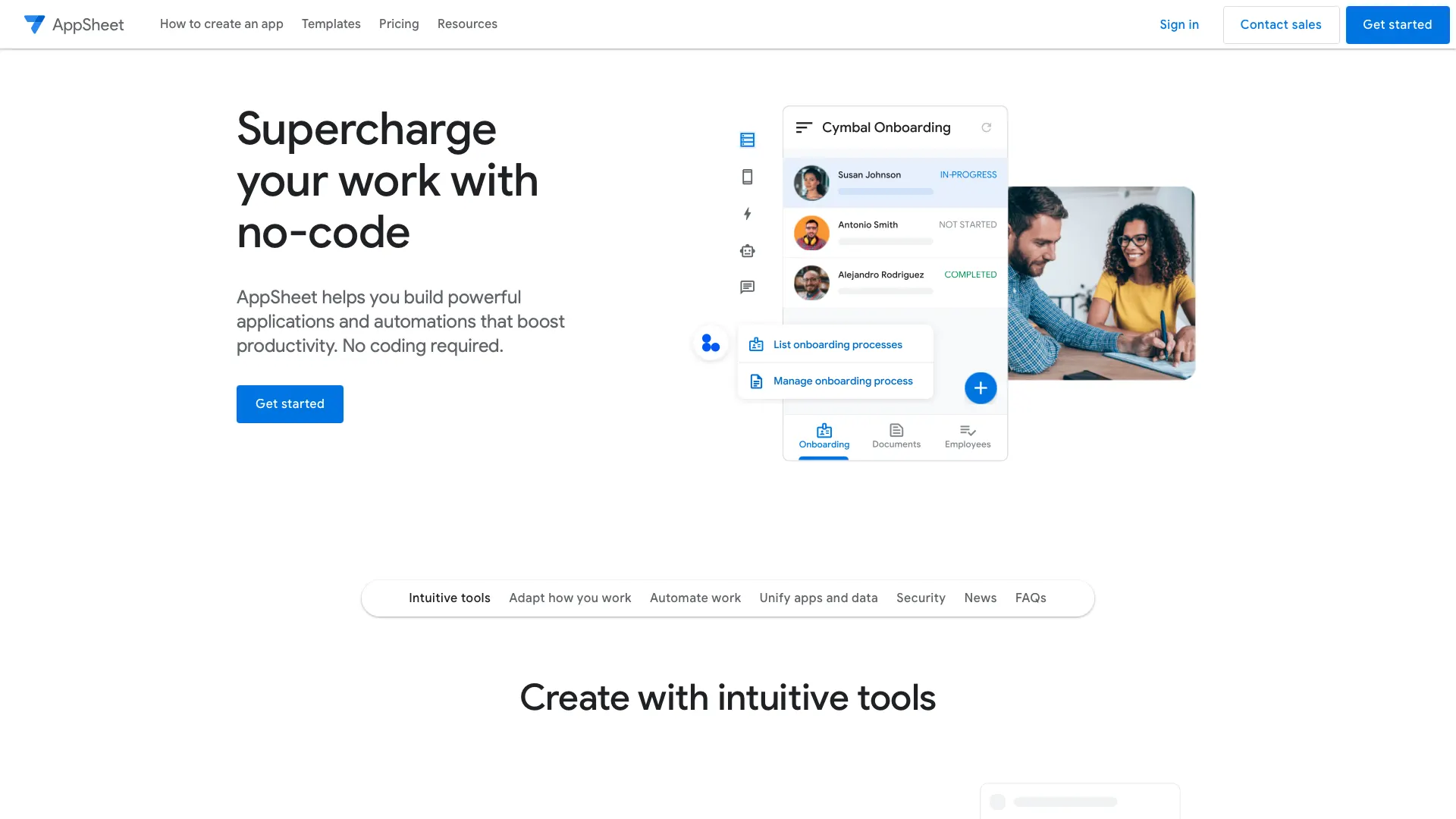 (AppSheet Website)
(AppSheet Website)
Pros
With AppSheet, it’s possible for non-techincal colleagues to output working applications in just a few minutes using data contained in a spreadsheet or external SaaS platform, like Salesforce.
Very little programming knowledge is necessary, besides basic concepts. Business logic is largely implemented using visual tools or common spreadsheet formulae.
Deployment is also highly flexible. AppSheet offers instant deployments, with a developer experience that will be highly familiar to WorkSpace users. Or, you can opt for custom deployments - including external app stores.
Cons
Where AppSheet falls short relative to other Retool competitors is customization. Ultimately, there’s an inherent tradeoff between how much flexibility it can offer and the extent to which it can empower less technical users to build applications.
It’s a no-code platform, so usability comes at the expense of the power to add more extensive customisation, although there is support for Google Apps Script functions, as well as tools for building AI-powered automations.
Realistically, AppSheet is also aimed at smaller-scale projects than its competitors. It’s part of the WorkSpace ecosystem, so more advanced functionality including self-hosting, external SSO, or other enterprise features is limited.
Pricing
AppSheet is free for up to 10 users. Beyond this, there are three paid tiers - Starter and Core are billed at $5 and $10 per user per month, respectively. These limit you to using spreadsheets and cloud file storage within your data layer.
You’ll need to opt for an Enterprise license at $20 per user per month in order to leverage external databases, SaaS platforms, or APIs as data for your applications.
So, AppSheet has the potential to be a cost-effective option for a range of different organizations.
7. Filemaker
Filemaker is one of the oldest names in the low-code space, having been around since the 1980s.
However, in recent years it’s pivoted towards a new niche, helping teams to output AI-powered applications.
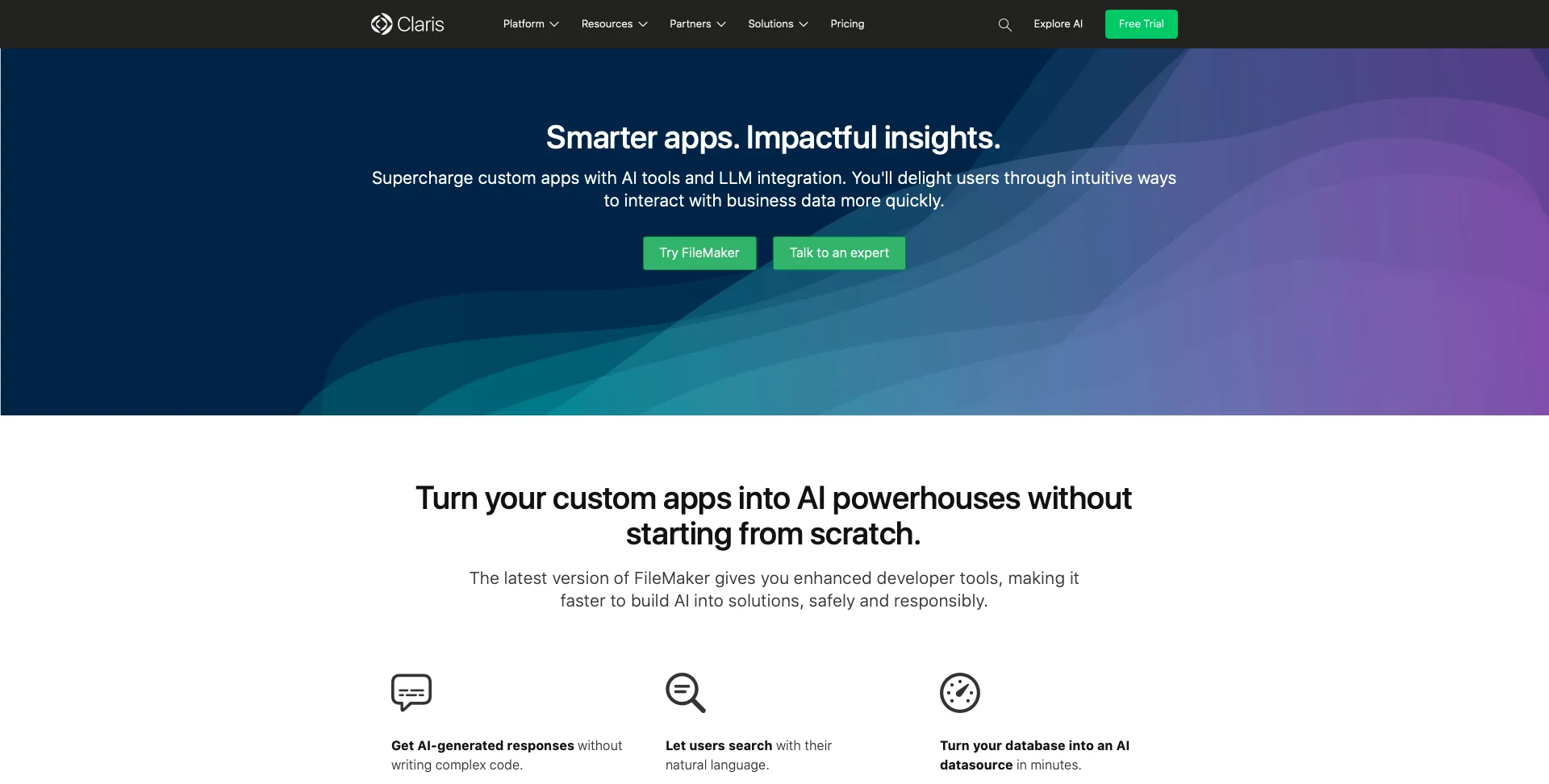 (Filemaker Website)
(Filemaker Website)
Pros
At its core, Filemaker is a low-code application development tool that allows us to build custom applications with AI capabilities, such as semantic search, retrieval, and document summarisation.
This can be powered by OpenAI or an open-source LLM that we run locally.
Another area where Filemaker is particularly strong is creating native mobile apps. For instance, it integrates directly with Apple’s App Store SDK, making it a great solution for creating custom iOS tools on top of existing business data.
Cons
However, there are some areas where Filemaker might leave you wanting. Some users complain that aspects of FileMaker’s UX feel a little bit more dated than some other platforms.
Many users also complain that Filemaker presents a relatively steep learning curve compared to alternative platforms, which place a greater focus on creating intuitive user experiences.
While Filemaker does offer support for external data, this is also somewhat limited compared to our other Retool alternatives. For instance, we’ll need to manually configure API requests or ODBC connections to work with NoSQL tools rather than using native connectors.
Pricing
Filemaker’s pricing positions it well towards the enterprise end of the market. It’s one of our more expensive options, with two fixed pricing tiers for the cloud product. For $22 per user per month, the Starter tier offers three applications for between five and ten users.
The Max tier ($45) expands these limits to 256 applications for up to 99 users. For 100 or more users, we’ll need to opt for custom enterprise pricing. Self-hosted Filemaker Server licenses start at $17.50 for up to 99 users.
On top of this, there are usage limits across all pricing tiers relating to data storage, API requests, and computing resources.
Take a look at our round-up of the top Filemaker alternatives .
8. Zoho Creator
Part of the wider Zoho ecosystem, Creator is a low-code platform that primarily seeks to enable IT teams and non-technical colleagues to collaborate on internal tools development.
So, IT teams can retain control over their internal data assets while still empowering on-the-ground teams to create solutions for their own needs - without undermining existing governance policies.
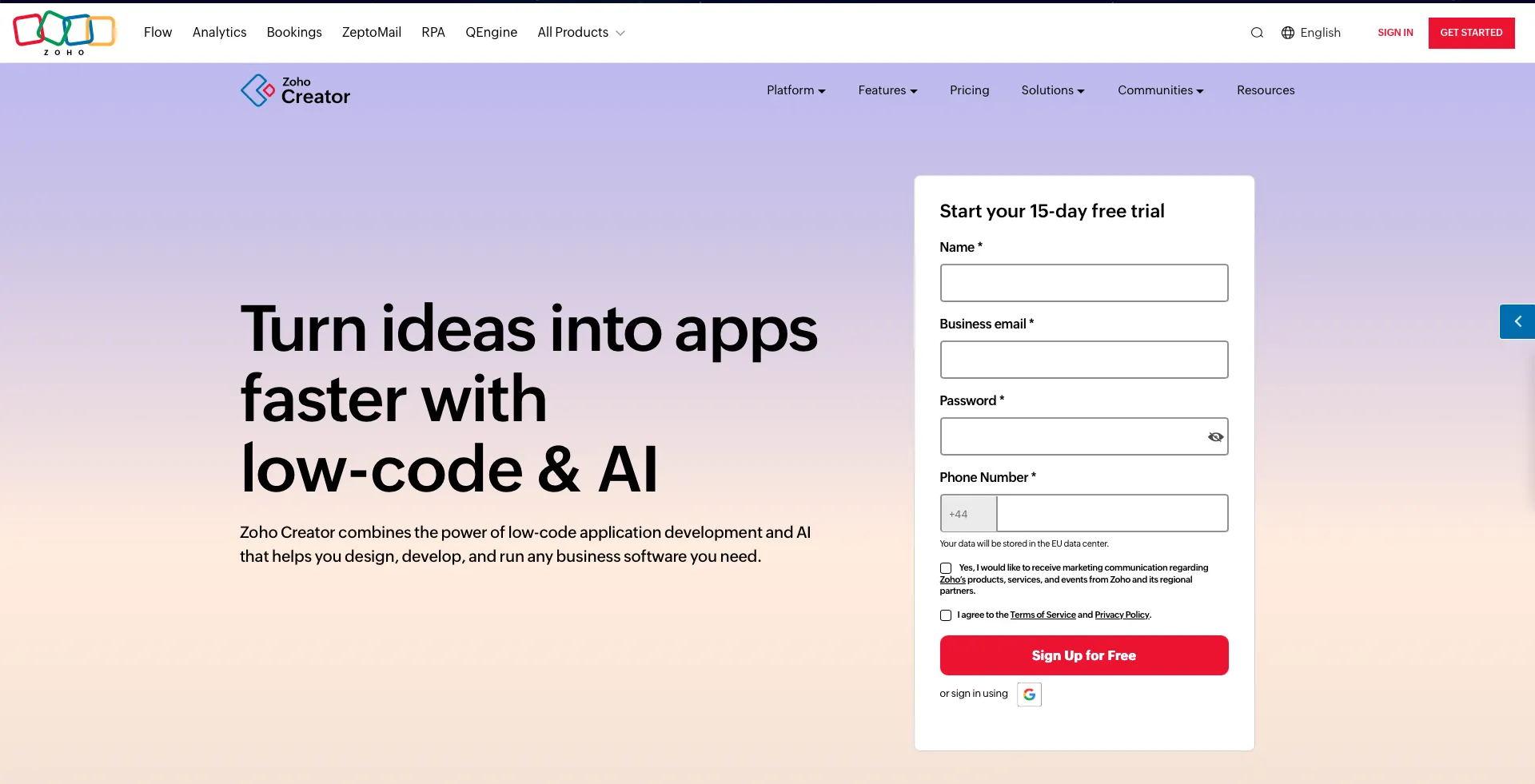 (Zoho Creator Website)
(Zoho Creator Website)
Pros
Compared to some other Retool competitors, Creator is a strong offering in terms of external data support. In particular, it offers extensive options for natively integrating with other SaaS tools, such as CRMs, ERPs, and marketing platforms.
One of the other real selling points here is the degree to which IT teams can retain control and governance. Creator offers flexible RBAC as well as custom security policies, so technical leaders can establish highly granular governance over how users interact with tools.
Creator also offers strong capabilities for using GenAI to output working applications, as well as capabilities for shipping native iOS and Android apps.
Cons
However, Zoho Creator is unlikely to be suitable for all use cases. In fact, it’s probably best suited to citizen development programs - where IT teams and non-technical colleagues each have a role in development processes.
Some users complain that it offers more limited customization options than some other Retool alternatives, so it may be less suitable for IT teams or professional developers.
Although it’s generally fairly affordable as we’ll see in a second, Zoho doesn’t offer a fully-featured free version of Creator, only a 15-day free trial.
Pricing
Creator’s pricing is based around four tiers, with the potential to be a very cost-effective option - although it’s worth noting that we’re limited to a single application on the Standard tier.
Zoho’s pricing also falls down somewhat in terms of predictability. There are additional usage-based limits in terms of connected data and automation runs, which might require us to upgrade to a more expensive license.
One potential upside is that certain enterprise features like SSO can be purchased as an add-on for all pricing tiers - although these are free across the board with some other platforms.
9. Quickbase
Quickbase’s raison d’etre is empowering teams to de-silo data. In effect, it’s a low-code database with additional features on top of this for designing interfaces and automating data management workflows.
However, unlike most other Retool alternatives, it’s focused on a relatively narrow range of use cases - primarily project, task, and resource management.
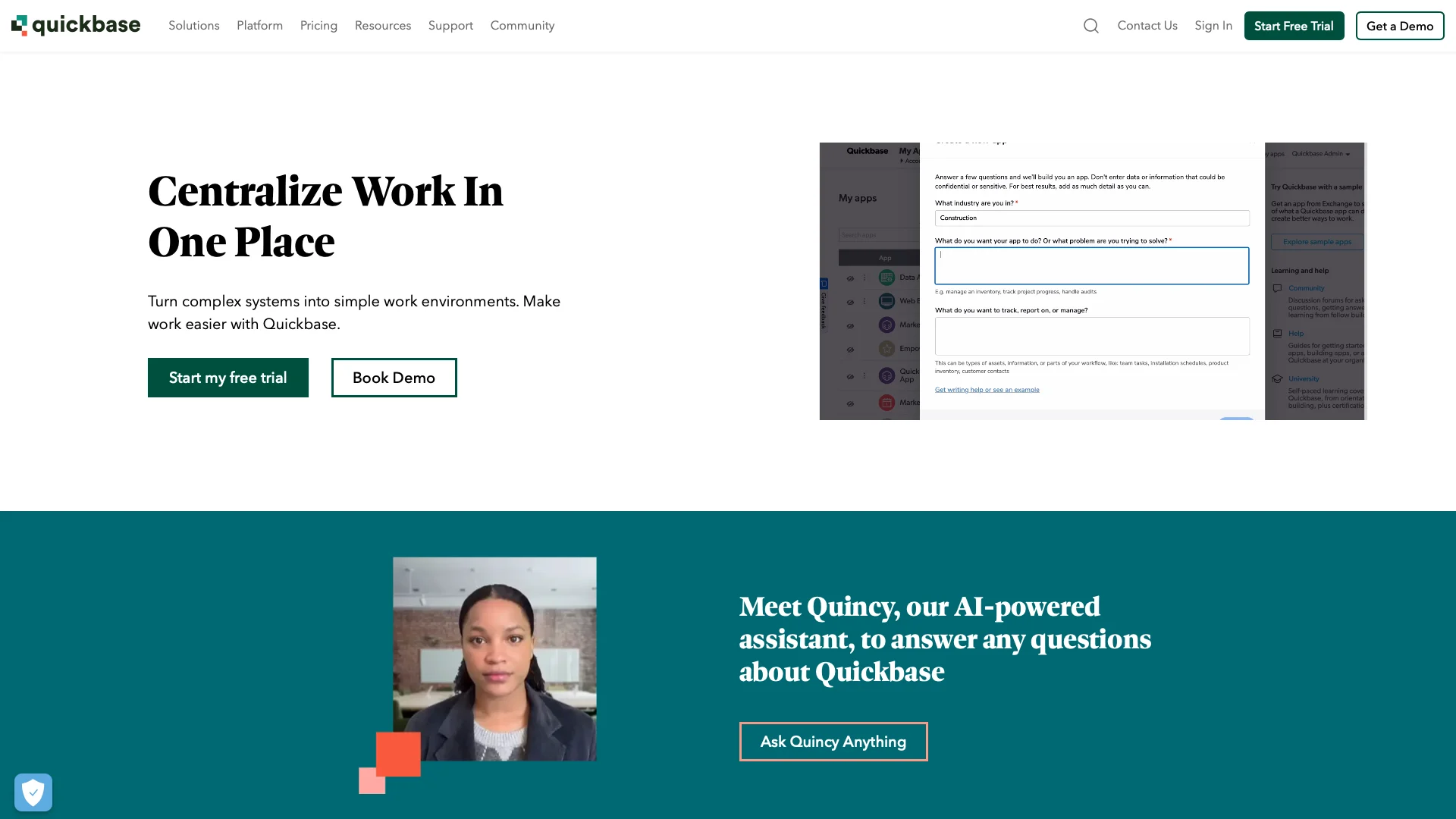 (Quickbase Website)
(Quickbase Website)
Pros
Quickbase makes it particularly easy for non-technical colleagues to ship working tools - especially for relatively simple use cases like forms, dashboards, and reporting, with an intuitive WYSIWYG editor, alongside an AI assistant to help us create apps.
It’s also an effective solution for larger teams. For example, Quickbase offers a range of security features like RBAC, custom governance policies, admin functionality, and more - helping IT teams control how users interact with data.
There’s also an effective visual builder for automating tasks, helping non-technical colleagues to create more advanced solutions without requiring extensive coding skills.
Cons
One of Quickbase’s potential pitfalls is that it’s optimized for a relatively small subset of use cases. So, it’s a great option if you want to build internal tools for managing projects or tasks, but it might leave something to be desired for applications outside of this.
Despite being aimed at a less technical user persona, a common complaint is that Quickbase presents relatively complex experiences for performing certain tasks - for instance, connecting to external data sources.
Additionally, it’s one of the more expensive platforms in our round-up today. It’s also fully closed-source, which will mean that it’s not a viable option for certain businesses.
Pricing
Quickbase is one of the few Retool alternatives we’ve seen today that doesn’t offer a fully free tier. Rather, there’s a 30-day free trial. Besides this, the cheapest price point is the Team tier, which bills at $35 per user per month.
The Business tier bills at $55 per user. This will unlock key security features like SSO and SCIM provisioning, as well as additional UI tools, including interactive Gantt charts.
We can also opt for custom enterprise pricing to access additional security features and enhanced audit logging.
10. Caspio
Caspio is another one of the older players in the low-code space, having been around since the year 2000. It has a clear focus on enabling business users in large enterprises to output working web apps.
It’s another platform that’s primarily built around a low-code database with interface design tools on top of this.
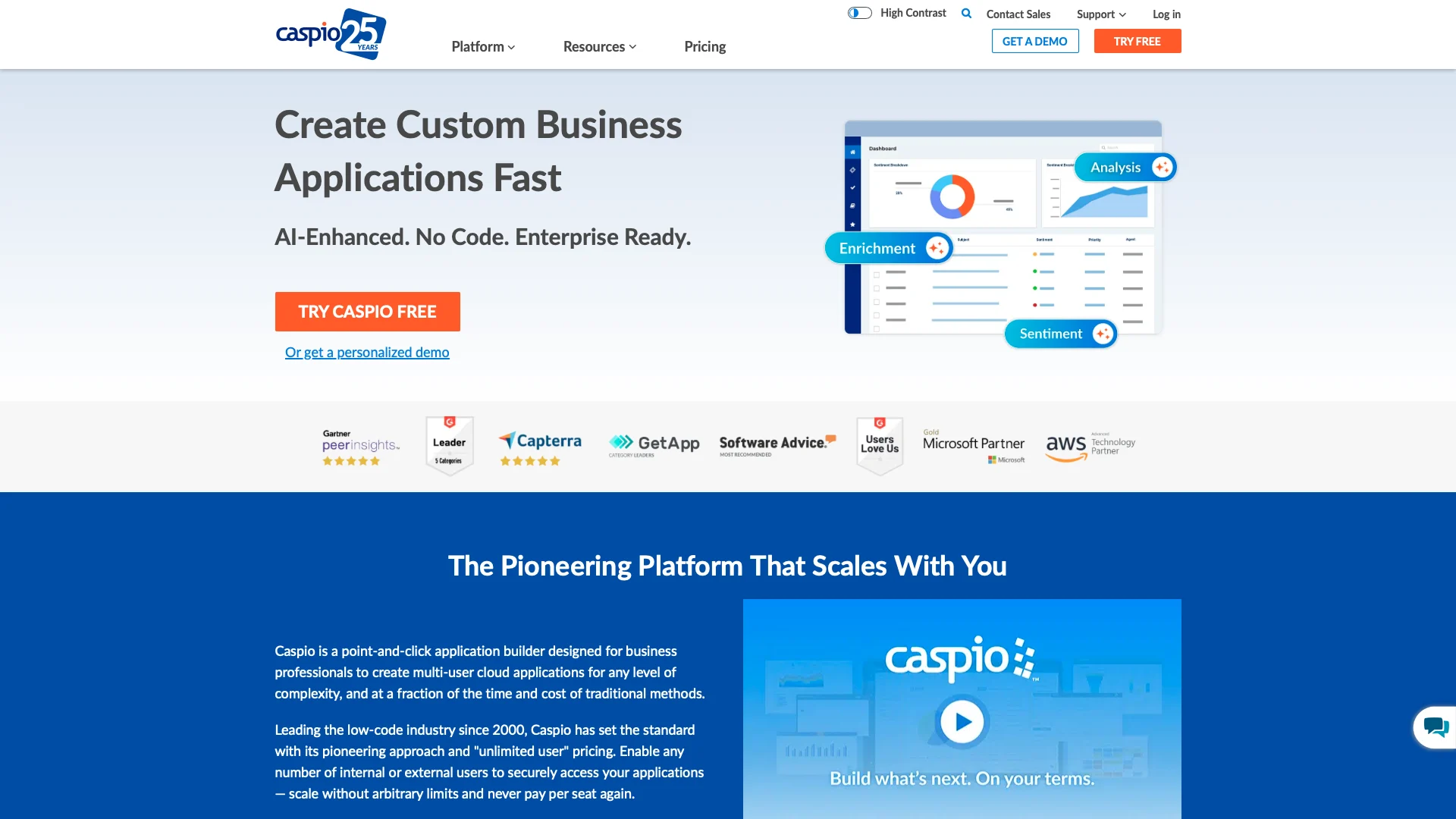 (Caspio Website)
(Caspio Website)
Pros
One unique selling point of Caspio is that its internal database is built on top of SQL Server. This means that users can have a high degree of confidence in the security and scalability of their stored data.
Additionally, we can use custom SQL statements within the platform to enhance and manipulate our data, as well as utilizing JavaScript, HTML, and CSS.
As one of the larger players in the space, Caspio also has a strong reputation for stability, prompt support, and a large, active community of users, making it an attractive option for teams that prioritize reliability.
Cons
Compared to more modern alternatives, Caspio’s UIs may feel a little bit dated - both in terms of the platform itself and the applications we can build with it - although it is still perfectly effective in terms of building working interfaces.
It’s also somewhat lacking in terms of automation functionality. We can build very simple data management automations using Triggered Actions and Tasks - but some other platforms are more sophisticated in this regard. Notably though, Caspio has also launched a range of no-code capabilities for building AI-powered workflows.
Lastly, Caspio lacks many of the key features of more modern low-code tools - especially direct connectors for external data sources. If we want to access external data, several other platforms offer more streamlined experiences.
Pricing
Interestingly, Caspio is one of the few platforms that doesn’t bill on a per-user basis. Rather, all monthly and annual licenses offer unlimited seats for a fixed price. This means that it could be a very cost-effective option for large user volumes.
There are four pricing tiers - Lite ($90), Plus ($270), Business ($540), and Enterprise (custom). Each of these is limited in terms of stored records and the DataPages we can build. A DataPage is essentially any UI element that allows us to take a database action.
Specific features are also limited to different pricing tiers. For example, SSO is limited to the Enterprise plan.
Retool vs Budibase
Now that we’ve seen a range of options from across the low-code market, it’s time to dive deep into how Budibase and Retool stack up.
Pricing
Budibase offers by far the most generous free tier of any Retool competitor. Build unlimited applications with up to five users in the cloud or twenty users if you self-host.
Our free tier even includes SSO, along with embeds and multi-player collaboration.
Our premium tier is billed at $50 per creator and $5 per user per month, giving you custom branding, configurable access to views, synchronous automations, and more - many of which are only available from Retool via custom pricing arrangements.
Data
Retool and Budibase both offer extensive ranges of native database connectors - including MySQL, Postgres, SQL Server, and a whole host of NoSQL tools, APIs, and other common data sources.
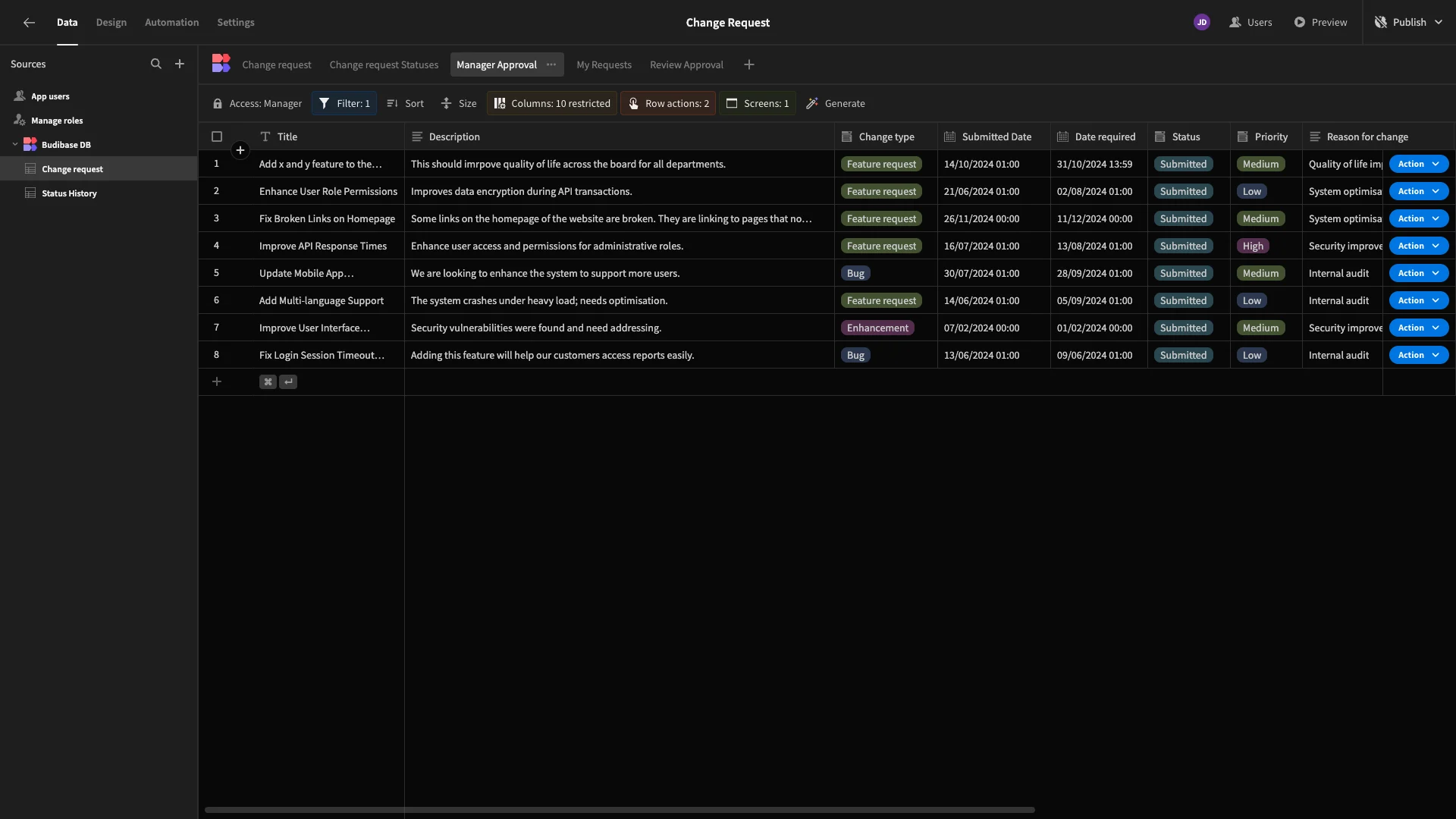
However, the big distinction here is that Budibase offers custom data sources.
Using our dedicated plug-ins CLI, self-hosted Budibase users can write their own data sources by defining CRUD actions which can then be implemented from within your application project - providing unrivaled flexibility for harnessing existing data.
Developer experiences
Retool and Budibase are aimed at subtly different kinds of users. Retool is primarily aimed at developers and engineers who want to build internal tools more quickly.
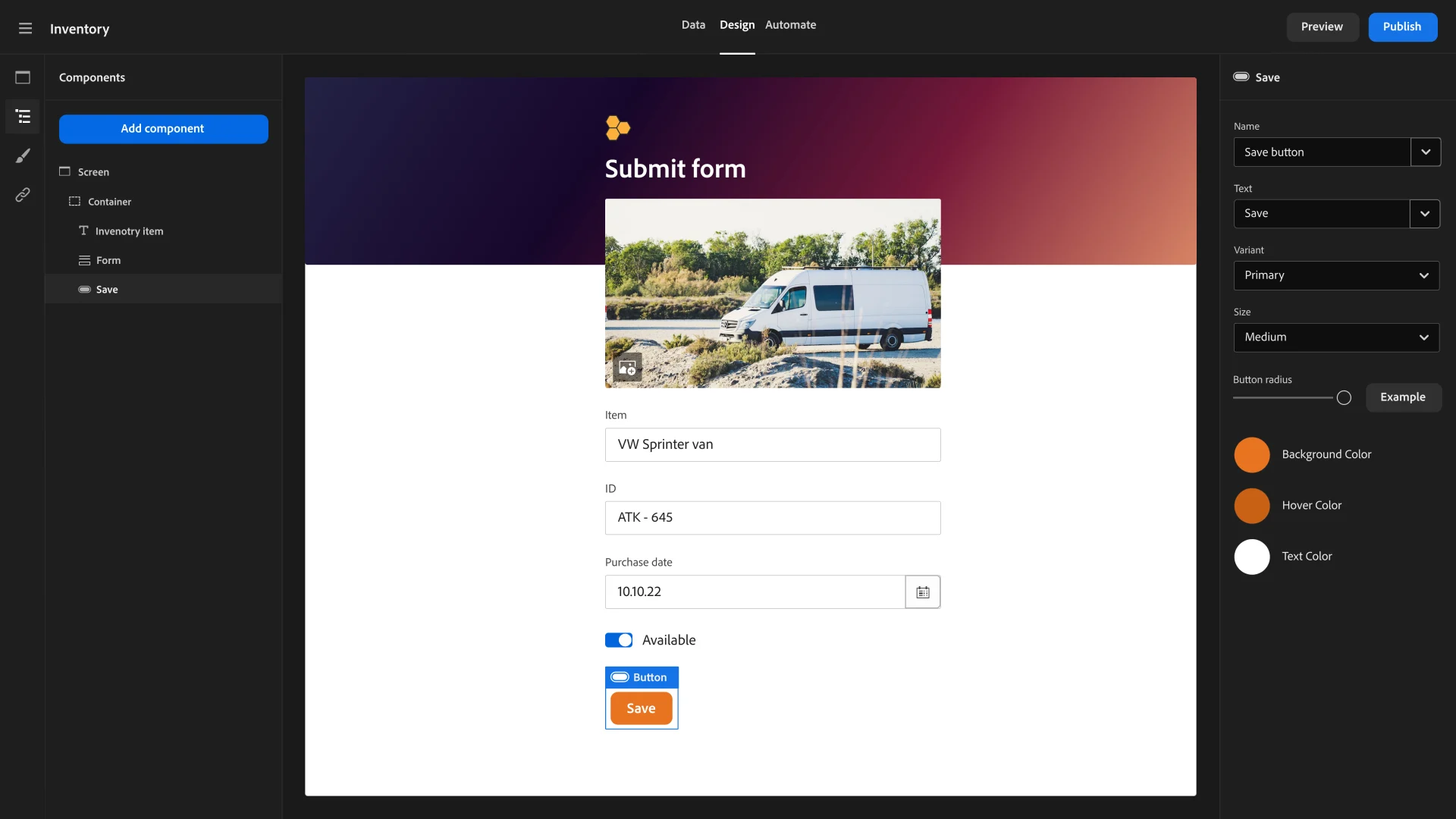
Budibase can be used in a similar way - with custom JavaScript available throughout our application builder - but our primary goal is to empower technical non-developers to turn data into action.
So, Budibase provides a highly streamlined UX for creating complex UIs and processes, including adding conditionality rules to components, manipulating data with handlebars helpers, or creating iterative automations.
Functionality
Naturally that there’s a lot of overlap between Budibase and Retool in terms of functionality. But, feature for feature, we’re confident that Budibase packs more advanced functionality into a more accessible, affordable package.
We offer free SSO across the board, custom branding for non-enterprise customers, active directory sync, environment variables, custom data sources, and much more.
Budibase also offers huge flexibility for how you deploy your app - with a wide range of supported methods, including Ansible, Azure, Digital Ocean, Kubernetes, Podman, Linode, Portainer, and more.
How to choose a Retool alternative
To wrap up, we want to outline a few key decision points. After all, we have a horse in the race, but it’s not realistic to think any single platform would be right for every buyer.
Therefore, it’s important to flag some of the most important tradeoffs, personas, and priorities when selecting a platform in this class.
Budgeting
Pricing might seem like the easiest decision point to wrap your head around, but in practice, this can actually be quite complex. The trouble is, we’re generally not comparing like with like - as vendors structure and calculate their pricing very differently.
The first variable we need to nail down is the number of users we’re dealing with.
As we’ve seen, almost all platforms distinguish between app creators and end users - and bill accordingly. Luckily, it’s relatively straightforward to establish the number of users we need. What’s trickier is accounting for how these costs will scale.
For example, Budibase has some of the most generous user limits in the free tier, while other platforms are more prohibitive in their pricing.
The other issue we need to consider under budgeting is where specific pieces of functionality are positioned across pricing tiers.
One way to approach this is to distinguish between requirements and nice-to-haves. Focusing on firm requirements - for instance, SSO, SCIM, air-gapped deployments, or multi-player collaboration - gives us an unambiguous point of comparison when it comes to budgeting.
Source-available vs closed-source
This is perhaps the biggest cleavage across the market for Retool alternatives. Transparent, auditable code is also a potential deal breaker - especially for enterprises or users in security-first organizations more broadly.
Here’s a summary of how this breaks up:
 Retool |  Budibase |  Mendix |  Outsystems |  Appian |  PowerApps |  AppSheet |  Filemaker |  Zoho Creator |  Quickbase | Caspio | |
|---|---|---|---|---|---|---|---|---|---|---|---|
| Open-source vs Closed-source | Closed-source | Open-source | Closed-source | Closed-source | Closed-source | Closed-source | Closed-source | Closed-source | Closed-source | Closed-source | Closed-source |
Builder personas
Another huge decision point is who will ultimately be using whichever platform we choose to build tools. Broadly, the solutions we’ve seen today range from developer tools on one end of the spectrum - to more business-user-focused platforms on the other.
In between, we have tools aimed primarily at technical colleagues, with at least some coding or development skills - like data professionals, product managers, solutions architects, and other IT roles.
 Retool |  Budibase |  Mendix |  Outsystems |  Appian |  PowerApps |  AppSheet |  Filemaker |  Zoho Creator |  Quickbase | Caspio | |
|---|---|---|---|---|---|---|---|---|---|---|---|
| Target user technical levels | High - Engineers | Medium - Technical users | Medium - Technical users | High - Engineers | Medium - Technical users | Medium - Technical users | Low - Business users | Medium - Technical users | Medium - Technical users | Low - Business users | Medium - Technical users |
Extensibility
Extensibility is how much scope we have to add our own components, integrations, or other kinds of functionality to a platform - as well as building capabilities via integrations with external tools.
Obviously, it’s helpful to be able to extend the platforms we’re using to build tools - with the caveat that this may also leave us responsible for maintaining whatever extensions we’re using.